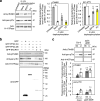Phosphorylation of plasma membrane H+-ATPase Thr881 participates in light-induced stomatal opening
- PMID: 38378616
- PMCID: PMC10879185
- DOI: 10.1038/s41467-024-45248-5
Phosphorylation of plasma membrane H+-ATPase Thr881 participates in light-induced stomatal opening
Abstract
Plasma membrane (PM) H+-ATPase is crucial for light-induced stomatal opening and phosphorylation of a penultimate residue, Thr948 (pen-Thr, numbering according to Arabidopsis AHA1) is required for enzyme activation. In this study, a comprehensive phosphoproteomic analysis using guard cell protoplasts from Vicia faba shows that both red and blue light increase the phosphorylation of Thr881, of PM H+-ATPase. Light-induced stomatal opening and the blue light-induced increase in stomatal conductance are reduced in transgenic Arabidopsis plants expressing mutant AHA1-T881A in aha1-9, whereas the blue light-induced phosphorylation of pen-Thr is unaffected. Auxin and photosynthetically active radiation induce the phosphorylation of both Thr881 and pen-Thr in etiolated seedlings and leaves, respectively. The dephosphorylation of phosphorylated Thr881 and pen-Thr are mediated by type 2 C protein phosphatase clade D isoforms. Taken together, Thr881 phosphorylation, in addition of the pen-Thr phosphorylation, are important for PM H+-ATPase function during physiological responses, such as light-induced stomatal opening in Arabidopsis thaliana.
© 2024. The Author(s).
Conflict of interest statement
The authors declare no competing interests.
Figures






Similar articles
-
The protein kinase inhibitor, tyrphostin AG126, and its derivatives suppress phosphorylation of plasma membrane H+-ATPase and light-induced stomatal opening.Plant Cell Physiol. 2025 Aug 12;66(7):1020-1029. doi: 10.1093/pcp/pcaf050. Plant Cell Physiol. 2025. PMID: 40396646 Free PMC article.
-
Light-induced stomatal opening requires phosphorylation of the C-terminal autoinhibitory domain of plasma membrane H+-ATPase.Nat Commun. 2024 Feb 20;15(1):1195. doi: 10.1038/s41467-024-45236-9. Nat Commun. 2024. PMID: 38378726 Free PMC article.
-
Red Light-Induced Phosphorylation of Plasma Membrane H+-ATPase in Stomatal Guard Cells.Plant Physiol. 2018 Oct;178(2):838-849. doi: 10.1104/pp.18.00544. Epub 2018 Aug 13. Plant Physiol. 2018. PMID: 30104254 Free PMC article.
-
New insights into the regulation of stomatal opening by blue light and plasma membrane H(+)-ATPase.Int Rev Cell Mol Biol. 2011;289:89-115. doi: 10.1016/B978-0-12-386039-2.00003-1. Int Rev Cell Mol Biol. 2011. PMID: 21749899 Review.
-
Tripartite hormonal regulation of plasma membrane H+-ATPase activity.Trends Plant Sci. 2022 Jun;27(6):588-600. doi: 10.1016/j.tplants.2021.12.011. Epub 2022 Jan 13. Trends Plant Sci. 2022. PMID: 35034860 Review.
Cited by
-
Origin and evolution of auxin-mediated acid growth.Proc Natl Acad Sci U S A. 2024 Dec 17;121(51):e2412493121. doi: 10.1073/pnas.2412493121. Epub 2024 Dec 10. Proc Natl Acad Sci U S A. 2024. PMID: 39656208 Free PMC article.
-
Stomatal opening under high temperatures is controlled by the OST1-regulated TOT3-AHA1 module.Nat Plants. 2025 Jan;11(1):105-117. doi: 10.1038/s41477-024-01859-w. Epub 2024 Nov 29. Nat Plants. 2025. PMID: 39613896
-
The protein kinase inhibitor, tyrphostin AG126, and its derivatives suppress phosphorylation of plasma membrane H+-ATPase and light-induced stomatal opening.Plant Cell Physiol. 2025 Aug 12;66(7):1020-1029. doi: 10.1093/pcp/pcaf050. Plant Cell Physiol. 2025. PMID: 40396646 Free PMC article.
-
TOT3-AHA1 module: its role in fine-tuning stomatal responses.Front Plant Sci. 2025 May 29;16:1582196. doi: 10.3389/fpls.2025.1582196. eCollection 2025. Front Plant Sci. 2025. PMID: 40510174 Free PMC article. Review.
-
Plasma membrane H+-ATPase activation increases global transcript levels and promotes the shoot growth of light-grown Arabidopsis seedlings.Plant J. 2025 Feb;121(3):e70034. doi: 10.1111/tpj.70034. Plant J. 2025. PMID: 39918907 Free PMC article.
References
MeSH terms
Substances
LinkOut - more resources
Full Text Sources

